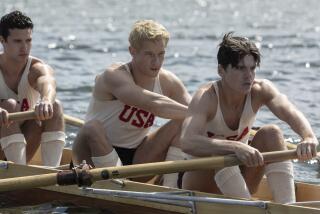Notebook : USA Now Regarded as Threat : Rivals’ Scorn Turns to Respect After 7 Straight Wins
- Share via
FREMANTLE, Australia — Skipper Tom Blackaller’s radical boat with rudders fore and aft, initially the object of skepticism and jokes, has become a force to fear in the America’s Cup competition.
After watching USA go from a 1-4 record to winning its next seven races, rival helmsmen admit that the 12-meter designed on computers by leading U.S. scientists is emerging as an intimidating foe. It has shown exceptional downwind speed in particular.
Even the Australians are uneasy. John Bertrand, who won the sailing world’s most prestigious trophy in 1983, notes that USA improved with every match.
“This boat is the most extreme in the regatta and could be a breakthrough,” Bertrand said.
“The boat is great,” said Harold Cudmore, Britain’s White Crusader skipper. “She’ll be on the top or out.”
Heart of America’s Buddy Melges regards Blackaller’s performance as the only surprise of the first series.
“He’s come far greater than anyone else,” Melges said.
The obvious progress is particularly satisfying to the dynamic, white-haired skipper of the Golden Gate Challenge, up against far wealthier efforts.
Noting that the San Francisco-based challenge has spent only $5 million so far, Blackaller said: “We’re the little guys, and we have to have something special. A victory in sports shouldn’t come because of dogmatic dedication, time and money. What’s exciting is a great idea and talented people.”
Blackaller, 46, who spent the first series geting used to the yacht, is ready to challenge the 11 opponents.
“This is really different than any other boat any of us have ever sailed,” said Blackaller, who skippered the unsuccessful Defender in the defense trials three years ago at Newport, R.I.
“When you get out and race you put your ideas on the line and see how they stack up against conventional wisdom and what everybody else is doing. The trick is to turn a good idea into reality.”
Controlling USA was the first priority. For Blackaller, that meant learning the intricacies of the steering system and anticipating the responses.
“Some of the time we didn’t know what the boat was going to do,” Blackaller said. “We didn’t know what techniques to apply.”
Starts were particularly precarious. As other crews were maneuvering for a strategic position at the start, Blackaller said: “Our whole game plan was to get away from the starting line without fouling out or crashing into the race committee boat.
“We’ll be a lot better in November than we were in October and there will be more gains in December. Our crew is not as well-practiced as the other crews because we’ve been working on getting our boat tuned up.”
Colin Beashel, skipper of Australia IV, will try to reverse a 43-second loss to Kookaburra III today in the second meeting of the boats in the first round of the defender trials.
Despite the loss, syndicate director Warren Jones maintains that Australia IV is the fastest 12-meter afloat when sailing in its designed “upper range” winds. But the defeat by Kookaburra III and a near setback against Kookaburra II has proved that Australia IV will at least be tested.
For some of the single-boat challenge syndicates that fared poorly, surgery has been the first priority between the first and second rounds.
With the graphically dazzling Eagle hauled out of the water, skipper Rod Davis watched as about 900 pounds of weight were removed from the keel so that sail area could be increased.
“I’m not proud of our racing record (4-8),” Davis said. “Obviously we’d like to win every race. But we’re looking at the first round robin as an opportunity to assess our strengths and weaknesses. That’s why we’re making changes. When something is out of whack, the boat goes slower.
“We’d like to get seven or eight wins in the next series and keep climbing. The important thing is where we go from here, and we wouldn’t be working this hard if we didn’t think we could make it.”
Heart of America, with 10 inches added to the overall length of the keel and more than 1,000 pounds of interior ballast moved, will point higher, Melges said.
Finally having a sufficient number of sails and a new mast, Melges, at 56 the oldest helmsman, figures his 3-9 record will rapidly improve.
“Our boat is near to its optimal mast tune,” he said. “Now that our sails are in hand, we are using the best technology available to recut and reshape them every day.
“The Kiwis, America II and Stars & Stripes are at the top of the game right now and have given us a target to shoot at. This first tuneup period has provided us with valuable input to utilize during our down time.”
Four crewmen from the beleaguered Courageous IV were charged by police Thursday with damaging a $23,000 mainsail they were reportedly tearing up for souvenirs.
Police said Robert Thomas Bennett, 26, of Chicago, appeared in court and that the others--Steven Wayne Humphrey, 31, of Oklahoma City; John Dennis Ahern, 23, of Salem, Mass., and Donald Greg Stokes, 35--were scheduled to appear today.
The workers were charged with stealing and inflicting damage on the mainsail.
The Courageous IV team withdrew from the America’s Cup competition after the 12-year-old boat and two-time Cup defender suffered staggering defeats.
More to Read
Go beyond the scoreboard
Get the latest on L.A.'s teams in the daily Sports Report newsletter.
You may occasionally receive promotional content from the Los Angeles Times.






